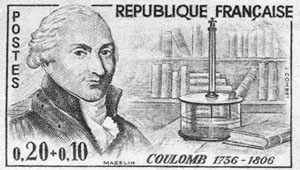Electric Force & Charge
Introduction Certain particles in nature exert forces on each other. If you rub two balloons on your hair and then hang them from strings and bring them close to each other, they will clearly repel each other. The same balloons will attract other things, such as little bits of paper. This simple experiment tells us that, whatever property of nature causes these forces, there are at least two types. In the 1700s, when experiments of this type were first being done, the name charge was used to label the mysterious property of matter responsible for these forces.
It was Benjamin Franklin who decided to call the two types of electric charge positive and negative. This was a good thing, because even though Franklin didn't have a good way to measure the amount of charge in his experiments, when later that became possible it was then natural to +'s and -'s to those numbers as appropriate.
Positive charges repel other positive charges, and negative charges repel other negative charges. In other words, like charges repel.
Positive charges attract negative charges. In other words, opposite charges attract.
Electrons are negative; protons are positive, and neutrons are neutral (have no charge). It is a strange and interesting fact that electrons and protons have exactly the opposite charge. In other words, an electron and proton together are exactly neutral. This, despite the fact that the proton has 1836 times the mass of the electron!
Most things around us have just as many negative electrons as positive protons, making the object neutral overall.
Activities & Practice
to do as you read
1. Play with John Travoltage.
2. Play with Balloons and Static Electricity
Units for Measuring Charge
The most fundamental unit for measuring charge is the magnitude of the electron charge, e. This is positive, so we say that the charge on a single electron is -e, and the charge on a single proton is +e.
Have you had chemistry? If so, you may remember talking about ions of various kinds. Like, ammonium (NH4+), sulfate (SO42-) and ferrous iron (Fe2+), which respectively have one fewer, two more, and two fewer electrons than they have protons. Because of those opposite charges, for example, the iron and sulfate stick together to make iron sulfate, FeSO4, a molecule that is neutral overall. The point here is that in chemistry class you were using the electron charge as the unit of charge measurements, although the letter e was not used. Also, if the charge is 1 chemists don't bother writing it, and they put the sign after the number, hence +, 2-, and 2+ in the previous examples.
One small problem: the elementary charge e is very small. Even in small, low-power electrical circuits there are billions of billions of electrons flowing through the wire every second. Using the electron charge as a unit would be like measuring the distance to faraway galaxies using millimeters. Instead, we'd like to have a unit of charge that is much larger for everyday use with typical electrical circuits. This unit is called the coulomb.
1 coulomb = 1 coul = 6.24x1018 electrons
The coulomb is named after Charles-Augustin de Coulomb, who in the 1770s and 1780s made many discoveries about electricity, magnetism and friction.

3. There are about 2x1028 electrons in your body. How many coulombs is that?
4. If there are so many electrons in your body, how come you don't think of yourself as 'charged'? In other words, how come you're not shooting sparks out all the time?
5. What is the charge of a single electron, in coulombs? (HINT: Use the FL method.)
6. A typical small LED (light-emitting diode) needs about 25 millicoulombs flowing through it every second in order for it to glow brightly. How many electrons is that?
What the What?
You may be wondering, why did the coulomb get defined to be this weird number. Wouldn't a nice round 1x1018 electrons be better. Well, it's all about the timing. The coulomb is actually defined in terms of electrical current (which we'll get to soon) and time. And this definition was agreed upon in the 1880s, well before the electron was discovered in 1897 and way before the charge of a single electron was measured. So when that measurement was finally achieved by Robert Millikin in 1909, it turned out that there were about 6.24x1018 electrons in a coulomb.